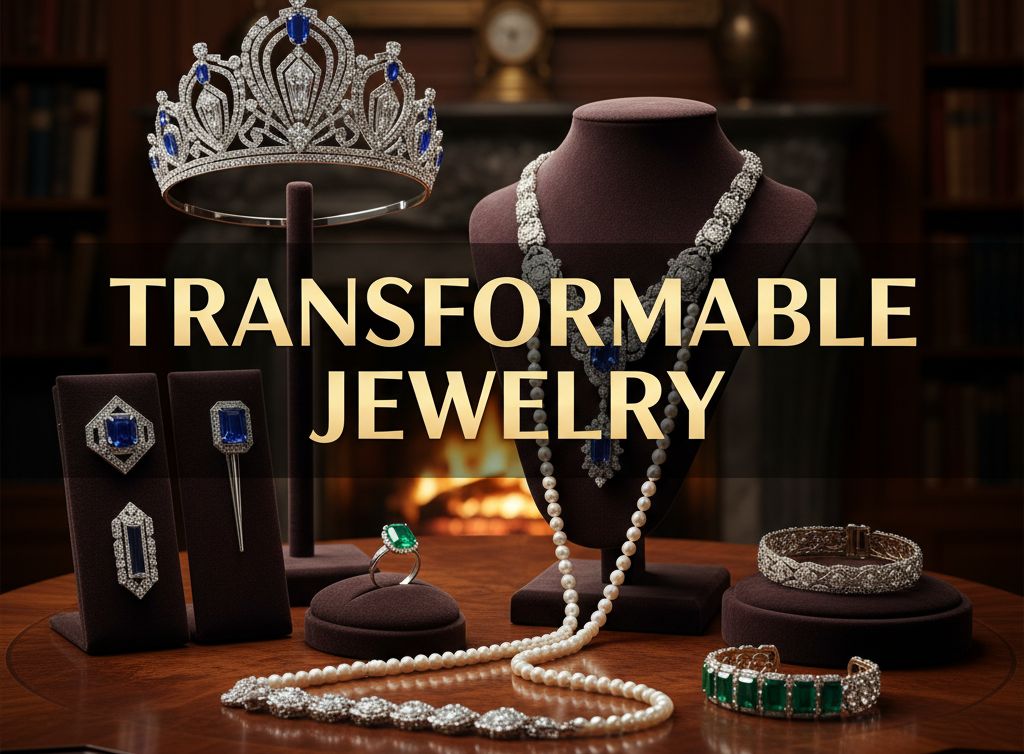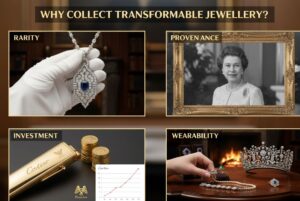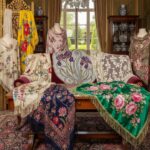More Than Meets the Eye: Unlocking the Genius of Transformable Jewellery
Imagine this: A tiara that can convert into brooches, necklaces that can turn into bracelets, and bracelets that can convert into rings. This is the magic of convertible jewellery. Convertible jewellery, also known as transformable jewellery, has been popular throughout the ages.
Antique jewellery that can be transformed into different pieces has been seen in different eras in various styles. These pieces of jewellery had multiple uses, so they could be worn for many different purposes.
This style of antique jewellery takes some clever design work and craftsmanship to ensure they work well; however, they are worn. The concept is both simple and ingenious: a single piece, multiple looks. By using hidden clasps, detachable segments, and clever engineering, jewellers gave wearers the power to reinvent their jewellery for different occasions.
This blog explores the rich history of transformable jewellery, how adaptable jewellery designs have been cherished across centuries, and the ingenuity behind its craftsmanship.

What is Transformable Jewellery?
Transformable jewellery, also known as convertible or modular jewellery, is a piece designed with cleverly detachable or reconfigurable elements that allow it to be worn in multiple ways. The core principle is plurality: one jewel conceals, or contains the potential for, several others.
This function is achieved through sophisticated mechanical devices: invisible catches, miniature screws, spring-loaded clasps, and ingenious hinge systems. The result is a single investment that maximises both wearability and style, allowing the owner to seamlessly transition a look from a grand daytime affair to a glamorous evening soirée.
Also Read: Why Jewellery Is The Perfect Gift
History of Transformable Jewellery

https://www.youtube.com/watch?v=_iIiAKp2ng4
Video Credit
The Jewellery Editor
thejewelleryeditor.com
The concept of reusing and reconfiguring precious materials is almost as old as jewellery itself, driven initially by practicality and later perfected by necessity and fashion.
- 17th – 18th Century: When Transformation Took Root
The French Revolution marked a dramatic turning point in the history of antique jewellery, as it brought about the destruction of many exquisite jewellery pieces. With a slow return to normalcy, luxury goods, especially jewellery, made a comeback. However, due to the war, precious gemstones were not available in abundance. This led to ingenuity in craftsmanship and the creation of jewellery suites that could be worn for different occasions.
- Napoleon Era and the Introduction of Parures
Imagine owning a jewel that breaks down into multiple pieces, with cleverly devised interchangeable components: necklaces that split into bracelets, brooches that transform into hair ornaments and much more.
Napoleon Bonaparte famously commissioned magnificent parures (jewellery suites) for his first wife, Empress Joséphine, and other royal relatives. Often, the central section of a magnificent diamond necklace could be unclipped and instantly mounted to a frame, creating a spectacular diadem or tiara. This ensured that the enormous cost of a piece could be justified across multiple uses.
- The Victorian and Edwardian Eras (1837–1910)
Day-and-Night Jewels: These pieces were exceptionally popular, allowing women to maintain the era’s strict social protocols. A delicate, small piece for the day was easily transformed by adding a long, grand section for evening balls and dinners.
Hair and Bodice Ornaments: Large, complex floral or spray brooches, known as bodice ornaments, were designed so that individual flower sprays could be detached and worn as hair ornaments or as smaller pins.
- The Belle Époque: Refinement and Romance
By the late 19th and early 20th centuries, during the Belle Époque, transformable jewellery reached new artistic heights. Jewellers like Boucheron, Cartier, and Van Cleef & Arpels mastered the art of modular design. Tiaras turned into necklaces for the opera. Pendant brooches doubled as hairpieces. Multi-part necklaces could be divided into smaller, wearable parts for daily use.
- The Great Depression and Art Deco Ingenuity (1920s-1930s)
Jewellery styles can be influenced by unusual events – and such was the case with convertible jewellery. The economic austerity of the Great Depression became the cornerstone for the greatest wave of convertible jewellery design. As budgets tightened, even the most affluent patrons needed to justify their luxury purchases. Jewellers saw an opportunity: create one sensational piece that could give the appearance of several.
- Mid-Century Transformables: Innovation and Iconic Glamour
The mid-20th century continued the legacy of transformable design, particularly in high jewellery. The world’s top houses—Bulgari, Chaumet, and Van Cleef & Arpels—redefined luxury for a new generation
Famous Examples of Transformable Antique Jewellery
The most coveted and celebrated pieces of transformable jewellery are those created by the great houses, whose technical mastery is legendary:
- The Poltimore Tiara:

Named after its original owner, this famous piece was purchased by Princess Margaret in 1959. A prime example of Garrard’s expertise in transformable jewels, the Poltimore Tiara can be worn as a tiara, a necklace, and as 11 separate brooches.
2. Queen Alexandra’s Kokoshnik Tiara: Inspired by traditional Russian headdresses, this tiara is also convertible into a necklace. It was inherited by Queen Elizabeth II and worn at many state occasions.
- The Van Cleef & Arpels Zip Necklace:

Image credit Zip necklace | The Collection Van Cleef & Arpels
Perhaps the most famous piece of convertible jewellery ever created. The Zip Necklace boasted of an operational, full-length zipper crafted entirely from precious metal and jewels (often diamonds, rubies, or sapphires) that can be fully opened and worn as a long necklace, or zipped up and wrapped around the wrist to be worn as a stunning bracelet or choker.
How to Acquire Transformable Jewels Today
Antique and vintage convertible jewellery has become highly sought after by collectors.
Collecting these mechanical marvels is a thrilling pursuit. Due to their rarity, historical importance, and exceptional craftsmanship, antique and vintage transformable jewels are highly sought after.
The Auction House Advantage
Antique jewellery auctions are the primary marketplace for the finest antique and signed vintage pieces.
Tips for Buying at Auction:
- Do Your Homework: Research the jeweller, the period (e.g., Art Deco, Victorian), and similar pieces to set a realistic budget.
- Inspect the Mechanisms: The value lies in the smooth, secure functionality of the transformation. If possible, inspect the piece during the pre-auction viewing days.
- Read the Condition Report: Always request and meticulously read the condition report provided by the auction house’s specialist.
Why Collect Transformable Jewellery?

Transformable jewellery holds a unique place in the market—not only for its beauty and engineering, but for its investment potential. Collectors prize these pieces for several reasons:
- Rarity: Each transformable antique piece is a feat of craftsmanship, often custom-made or limited in production.
- Provenance: Many were owned by aristocrats, actresses, or royalty, adding historical and sentimental value.
- Wearability: Unlike purely ornamental antiques, these pieces adapt to modern life—wear one piece multiple ways.
The Modern Revival of Transformable Design
Today, as consumers embrace sustainability and versatility, transformable jewellery is making a strong comeback. Modern designers are reinterpreting the concept through contemporary materials and minimalist design.
Designers draw inspiration from historical pieces, infusing modern aesthetics with timeless versatility.
The Enduring Appeal
Transformable jewellery is a symbol of resourcefulness, showcasing the unparalleled skill of master jewellers who merged art and complex engineering.
From royal courts to red carpets, transformable jewellery has evolved for centuries without losing its magic. It’s a form of art where beauty meets utility, and where craftsmanship meets imagination.
Whether it’s a Victorian tiara that becomes a brooch or a modern necklace that folds into a bracelet, these pieces remind us that luxury can be intelligent, not just extravagant.






